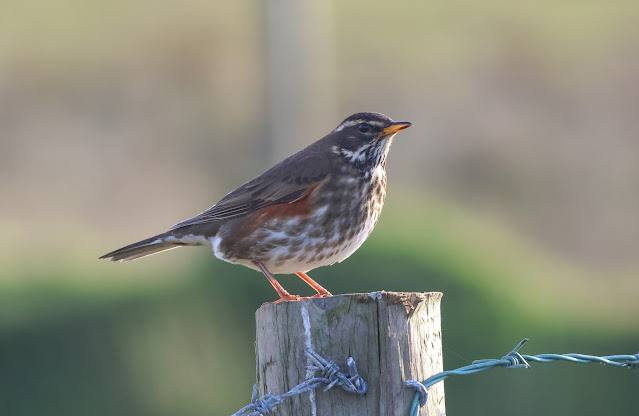18/04
It was a beautifully clear, calm morning on Enlli, with the wind picking up and shifting from south-westerly to a stronger westerly wind bringing light rain showers in the afternoon. The calm conditions first thing allowed the first breeding bird survey visit of the year to take place, starting at sunrise and covering the South End, Narrows Traeth Ffynnon and up to Ty Pellaf.
 |
A stunning sunrise at the South End © Kate Fox
|
A Grey Heron was touring the island, a Teal on Pwll Cain, two Red Kites with two Buzzards over the Mountain, seven Whimbrels around the island, a Redshank on Henllwyn, five Turnstones around the South End, a Stock Dove between Cristin and Nant and a Collared Dove around the Observatory garden.
In terms of migrant passerines, a Tree Pipit flew north over the South End first thing, and a total of seven Swallows, 21 Wheatears, 21 Blackcaps, 12 Chiffchaffs, 12 Willow Warblers and five Goldcrests across the island. It was a good day for Rooks, with 19 recorded. The Starling remained at Ty Pellaf, and finch counts came to 94 Goldfinches, ten Siskins, 85 Linnets, three Lesser Redpolls and a Chaffinch. In the afternoon, a Reed Bunting was also heard calling over the plantation at Nant.
Steve took the students on a guided walk up to Pen Cristin to show them the some of our star lichen species, the rare Ciliate Strap Lichen (Heterodermia leucomela) and Golden Hair Lichen (Teloschistes flavicans). Many then stayed up there for a couple of hours enjoying great views of Puffins on the slopes below.
 |
| Lichen-spotting at Pen Cristin © Steve Stansfield |
The afternoon was spent rockpooling around Solfach, finding a great range of shore-dwelling species. The highlights were two By-the-wind Sailors, Strawberry and Beadlet Anenomes, and two Shannies which they were able to identify with the help from books kindly donated by WildSounds! Joel also gave a crash course on seaweed ID, pointing out the differences between Serrated, Bladder, Egg and Spiral Wrack, and how to remember the scientific name for Oar Weed (Laminaria digitata) owing to its resemblance to a hand and fingers - hence 'digitata' for digits.
 |
| Rockpooling around Solfach © Kate Fox |
 |
| Using our new Rockpooling field guides donated WildSounds © Steve Stansfield |
The day ended with the legendary Bardsey Uni Week Quiz which was great fun for all (despite the devilish questions set by Steve!). 'The Great Tits' had a landslide victory, each winning a Bardsey Bird Observatory T-shirt.
 |
| Quiz night! © Steve Stansfield |


















































